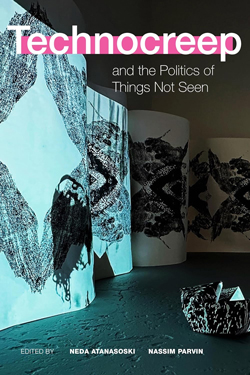Smart homes, health-tracking apps, voice assistants like Alexa, even pet robots can trigger an unsettling feeling that’s often referred to as creepiness. This sense of “creepiness” inspired Nassim Parvin to co-author “Technocreep and the Politics of Things Not Seen,” a book that examines the emotional and political dimensions of our relationship with everyday technology.
In the book, Parvin, a professor at the University of Washington Information School, introduces a feminist theory of “creep.” She wrote it in collaboration with Neda Atanasoski, professor and chair of the Harriet Tubman Department of Women, Gender and Sexuality Studies at the University of Maryland, with contributions from authors and artists of multiple disciplines.
 The origins of “Technocreep” began in 2018 in Santa Cruz, California. Atanasoki and Parvin were in a coffee shop and had a conversation about the creepiness of different surveillance technologies such as smart trashcans or smart piggybanks. Only a few months later, COVID-19 left people with no choice but to quarantine, and it became even more visible how much of the home environment had been infiltrated by digital technologies.
The origins of “Technocreep” began in 2018 in Santa Cruz, California. Atanasoki and Parvin were in a coffee shop and had a conversation about the creepiness of different surveillance technologies such as smart trashcans or smart piggybanks. Only a few months later, COVID-19 left people with no choice but to quarantine, and it became even more visible how much of the home environment had been infiltrated by digital technologies.
While it has no singular definition, Parvin and Atanasoski define creep across multiple dimensions such as intuition (a sense that something is there) or slow movement. These technologies are often in places where we expect privacy, which is part of why they can feel disturbing, but Parvin argues that there is more than privacy at stake. She invites readers to take the feeling that something is creepy as a starting point in creating better relationships with technology.
Parvin draws on feminist theory in “Technocreep’s” analysis to highlight how our understanding and design of technology is shaped by social contexts, histories and power dynamics. The book argues that labeling something "creepy" isn’t just about fear or discomfort, but also reflects complex dynamics of power, control, trust and intimacy.
“Instead of thinking about technology as a neutral tool, we need to think about it through a critical look at the kinds of relationships that it mediates in specific situations,” she said. “So the book moves away from the binary of good and bad technology and instead foregrounds the complex, and at times fraught, relationships that these technologies mediate.”
One of the major themes of the book is encouraging readers to think about technology beyond surveillance. It calls on them to reflect on the relationships they have with technology and how it engages different senses. “Technocreep” encourages readers to open themselves up to new possibilities.
“How can [technology] help us rethink our relationship with plants or rethink our relationship with work?” she said.
One “creepy” technology the book analyzes is Qoobo, a Japanese-designed robot that appears as a headless cat with its own heartbeat. The robot is designed to address loneliness and anxiety. While the image of a headless cat evokes “creep,” “Technocreep” encourages readers to rethink it by imagining a situation where a close friend might see it as a source of comfort and companionship. In this way, the book replaces the tendency to dismiss technology outright for a more nuanced approach.
“Technocreep” theorizes four dimensions of “creep.” First, it’s the slow, barely noticeable advance of technology. Second, it's a feeling — something eerie or unsettling that you sense more through touch or intuition than sight. Third, it echoes the way vines creep, growing against the odds. Finally, it describes the instinctive reaction to something or someone that feels “off,” challenging our sense of what’s normal.
The book also features artists and scholars of various disciplines who offer different perspectives on “Technocreep.” Parvin and Atanasoski argue that writing about a complex topic requires multiple outlooks in order to make real progress.
“It's rewarding thinking about how we might reorient our approaches to book writing and theorizing, which tends to be a single-author solo process, to open it up as a collective thinking process that's more capacious and also responsive to the complexity of technologies,” Parvin said.
Artists’ contributions draw attention to the idea that there are different ways of knowing the world, emphasizing the importance of reimagining the who and how of technology design and criticism.
“That's actually been one of the joys of the project,” she said. “To think about artistic interventions as ways to rethink and reimagine technologies.”
Before the book was released, it was already ranked among the top 20 bestsellers on Amazon in politics and privacy surveillance and it has remained in the top 100 ever since. Parvin and Atanasoki have also been featured on the Good Robot Podcast. The Seattle book launch is scheduled for 7 p.m. on Sept. 2 at Elliott Bay Book Company, where Parvin and Atanasoski will present and discuss the book alongside five of the contributing authors and artists.
Parvin hopes readers leave with a sense of curiosity, building upon their own knowledge and ways of being with and using technology.
“I think that creepiness has a productive ambiguity that I hope our readers can build on,” she said. “It is that ambiguity that can be a source of possibility and open up these technologies in new and exciting ways.”
